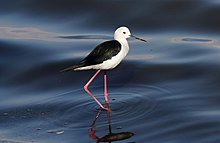|
Stilt
Stilt is a common name for several species of birds in the family Recurvirostridae, which also includes those known as avocets. They are found in brackish or saline wetlands in warm or hot climates. They have extremely long legs, hence the group name, and long thin bills. Stilts typically feed on aquatic insects and other small creatures and nest on the ground surface in loose colonies. Most sources recognize 6 species in 2 genera, although the white-backed and Hawaiian stilts are occasionally considered subspecies of the black-necked stilt. The genus Charadrius was introduced by the French zoologist Mathurin Jacques Brisson in 1760 with the black-winged stilt (Himantopus himantopus) as the type species.[1][2] The generic name Himantopus comes from the Ancient Greek meaning "strap-leg".[3] SpeciesThe genus Himantopus contains five species:[4]
The genus Cladorhynchus is monotypic and contains a single species:[4]
A fossil stilt has been described by Bickart, 1990, as Himantopus olsoni, based on remains recovered in the Late Miocene Big Sandy Formation of Mohave County, Arizona, United States.[5] ReferencesWikimedia Commons has media related to Stilt.
|
||||||||||||||||||||||||||||||



